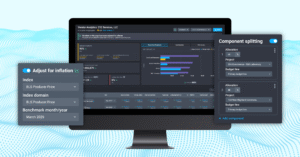Is your development firm still managing large, complex real estate projects with outdated tools? You’re not alone. For too long, the real estate industry has relied on traditional, error-prone workflows, even as the development process has become more complex. From underwriting to final draw requests, the development lifecycle is an intensive process that requires precise execution at every stage. Managing your projects with outdated workflows increases risk over the development lifecycle, potentially causing budget overruns, costly timeline delays, and reputational damage from siloed communication.
Development firms are increasingly looking to curb risk and enhance workflows adopting technology. Over 80% of real estate occupiers, investors, and developers reported plans to expand their real estate technology budgets in JLL’s 2023 Global Real Estate Technology Survey. The ascendance of AI in real estate has made the need to adopt new technology even more urgent, and is likely to bring sweeping technological change to the long-resistant industry. So, how can your firm choose the best real estate development software and maintain a competitive advantage?
Here, you’ll learn about the 9 best real estate development software options on the market, with an ROI conscious comparison to help you select the best option for your firm
How to Choose the Right Real Estate Development Software
When exploring the software for real estate developers currently on the market, evaluating your development firm’s specific needs is a good place to begin. Below, you’ll find a few key areas where real estate development software can assist, and the questions you can ask to determine the functionality you need.
- Project Lifecycle Coverage: Look at every stage of the development lifecycle, and address who on your investment, construction, or development team would benefit from the tools and what purposes would be most useful. Do you just need the platform for construction management, or would your team benefit from full lifecycle control from acquisition to project delivery?
- Financial Modeling and Budgeting Needs: Does your team need software to assist with budgeting? Will your team build pro formas, waterfall models, and due diligence processes internally?
- Stakeholder Collaboration: How many internal and external stakeholders (lenders, investors, architects) need access and visibility? How would real-time analytics uplevel your business’ ability to work cross-functionally?
- Compliance & Reporting: Are you managing multi-entity finances, audits, and investor reporting requirements? Will you need the capability to manage vendor compliance such as COIs, lien waivers, and more.
- Scalability & Integration: Will your needs grow and include more asset classes over time? Does your firm need a platform that can facilitate major portfolio growth, whether that’s larger projects, more projects, or both? What software is already in your firm’s technology stack, and do you need a platform that can integrate with existing technologies or workflows?
Comparison Chart
Once you’ve evaluated your development firm’s needs, you can explore the top development platforms and see if functionality meets all your needs. Use the comparison chart below to evaluate how each platform measures up.
| Full Development Lifecycle | Underwriting | Construction Management | Pre-Development | Vendor Management | Reporting and Analytics | |
|---|---|---|---|---|---|---|
| Northspyre | ✅ | ✅ | ✅ | ✅ | ✅ | ✅ |
| Procore | ❌ | ❌ | ✅ | Limited | Limited | ✅ |
| Acumatica ERP | ❌ | ❌ | ✅ (Modular) | ❌ | Limited | ✅ |
| BuilderTrend | ❌ | ❌ | ✅ (Residential Focus) | ❌ | Limited | Limited |
| Sage Intacct | ❌ | ❌ | ❌ | ❌ | ❌ | ✅ |
| DealPath | ❌ | ✅ | ❌ | Limited | ❌ | Limited |
| PlanGrid | ❌ | ❌ | ✅ | ❌ | ❌ | Limited |
| ARGUS Developer | ❌ | ✅ (Deep Modeling) | ❌ | Limited | ❌ | Limited |
| CoStar | ❌ | Limited | ❌ | ❌ | ❌ | Moderate |
| Autodesk BIM 360 | ❌ | ❌ | ✅ (Preconstruction/ Design) | ❌ | ❌ | Limited |
1. Northspyre
Best For: End-to-end real estate developers managing complex projects from acquisition through project closeout and stabilization.
Quick Overview
Northspyre is an end-to-end development management platform built by and for real estate developers. The software centralizes project stakeholders, data, and processes in an integrated and collaborative platform, You can simplify workflows and create more predictable outcomes on complex development projects with automation, analytics, and AI. The software also eliminates the need for tedious and outdates spreadsheets, helps mitigate budget overruns, and facilitates confident deal closeouts.
Ideal Use Case
Northspyre is designed for commercial real estate developers managing complex projects who want to boost efficiencies and maximize ROI at every stage of the development lifecycle, from acquisition to pre-development and construction to project completion and stabilization.
Standout Features:
- Early project planning functionality, including predictive budget tracking and lifecycle automation powered by AI, helps your team build reliable budgets and schedules.
- Northspyre’s Portfolio Analytics, Early Budget Planner, and AI Budget Optimizer help your development team create budget scenarios, evaluate bidding opportunities, and leverage historical performance insights to make informed decisions from the earliest stages of your project to keep costs down and avoid disruptions in the lifecycle.
Investor reporting tools such as Draw Request, Reporting, and Funding Portal eliminate the need to spend hours digging through emails and allow you to create comprehensive, compliant draw reports in hours, enhancing transparency and expediting funding processes with capital partners.
Cost
Project-based pricing
Pros
- Real-time financial forecasting functionality gives you a real-time line of sight on spending. You can accurately forecast spend, track actuals, and compare against past periods to assess performance and funding needs through the end of your project.
- Excellent cost control and data visibility eliminates the need to dig through siloed data and run time-consuming monthly reports to understand what’s going on with your budget. Budget management is simplified and centralized with Northspyre, allowing you to plan for exposures, identify opportunities to improve budget performance with actionable insights.
- Purpose-built by and for commercial real estate developers, and the platform enables users to make smarter and faster decisions across the design, development, and investment stages of building.
- Deep Integrations with existing tech stack to work alongside your existing tech stack through Open API and native accounting integrations. With the ability to integrate with accounting platforms such as Yardi, SageIntacct, MRI, and more, you’ll be able to centralize all data for your project teams and prevent miscommunications
Cons
- Northspyre may not be the best fit for already-developed buildings with property management needs, and is instead best tailored to the development lifecycle
2. Procore
Best for: General contractors or in-house GCs who need to manage field coordination, RFI’s, and build phase management.
Quick Overview
Procore dominates the construction management space, providing contractors and developers with field collaboration, RFIs, and construction ops capability. The platform is committed to helping construction and construction alone.
Ideal Use Case
Procore’s ideal user base is general contractors, architects or engineers, or owners who are heavily focused on construction execution.
Standout Features
- Field team collaboration tools increase the ability to connect your construction office with contractors, vendors, or workers who are on-site.
- Pay operations are also facilitated by the platform, with advanced capability to capture, document, and track out-of-scope work with T&M Tickets
Cost:
Custom quotes based on the scope of work
Pros
- Purpose-built for GC coordination and facilitating the construction phases
- Best-in-class for field operations, with mobile communication tools that work well for GCs overseeing project execution
- Powerful construction budget tracking, with capability for bid management and collaboration tools to connect building information modeling (BIM) and field teams
Cons
- Limited functionality pre-construction, with no underwriting and limited early project planning, draw reporting, or budgeting tools
- Specific functionality purpose-built for GCs working on site in construction with tools for field operations, contractor collaboration, RFIs, and pre-qualification for contractors
- Best suited for developers and general contractors focused on construction execution, not for development professionals with robust needs across the lifecycle
3. Acumatica ERP
Best for: Financially complex development firms needing deep Enterprise Resource Planning (ERP) level accounting and procurement systems.
Quick Overview
Acumatica is a generic cloud-based ERP planning platform for small and medium-sized businesses, and could be a strong choice for development firms needing financial control and back-office integration. Its modular structure supports accounting, procurement, and even construction workflows. Acumatica is a flexible ERP offering modular financial features appealing to firms in search of accounting-first solutions.
Ideal use case
Businesses looking for deep financial or operational control
Standout feature
- ERP-level financial and back-office management capabilities, including accounts payable, accounts receivable, general ledger, and more.
Cost
Price and cost tailored to usage
Pros:
- Good tool for firms needing back-office control
- Excellent financial modules for businesses
- Customizable for different business needs
Cons
- Longer setup and onboarding for firms and additional time to customize
- Meant solely for small and mid-market businesses so limited capacity to scale
- Generalization means limited capability created with commercial real estate developers in mind
4. Buildertrend
Best for:
Residential builders and remodelers managing high-volume, lower-complexity projects.
Quick overview
Buildertrend is an all-in-one construction management platform made with homebuilders, remodelers, and specialty contractors in mind. The platform aims to provide builders with sales tools to secure jobs and project management tools to run efficient job sites.
Ideal use case
Homebuilders, remodelers, or custom contractors managing multiple small projects.
Standout feature
- Buildertrend facilitates communication between clients and subcontractors, offering clients customized portals to allow them to create personalized dashboards where they can keep an eye on subcontractor progress
Cost
Pricing tailored to businesses based on projects, team size, and revenue
Pros
- Easy to adopt for small teams or builders
- Strong capability for builders who want to improve client experience with client-facing tools
Cons
- Limited scalability for commercial projects, better for smaller teams
- Created with builders and remodelers in mind, not underwriting or lifecycle management for larger-scale developers
5. Sage Intacct
Best for: Large real estate organizations needing cloud-native, multi-entity financial management without field execution tools.
Quick overview
Sage Intacct is a financial management system specializing in multi-entity accounting, audit-ready controls, and cloud reporting.
Ideal use case
Large real estate firms with complex financial operations that need comprehensive accounting capability.
Standout feature
- AI-powered accounting capability, automating accounts payable workflows, providing a general ledger that detects mistakes, and creating overall efficiencies for time-strapped accounting teams
Cost
Custom pricing based on business needs
Pros:
- accounting functionality for businesses of all sizes
- Integrates smoothly with other platforms in a tech stack, such as more development-specific software
Cons
- Built with accountants in mind, it offers no direct construction or commercial real estate specific development tools
6. Dealpath
Best for: Acquisition teams and investment managers focused exclusively on pipeline tracking and pre-investment workflows.
Quick overview:
Dealpath is a deal management platform helping acquisition teams track pipelines, due diligence, workflows, and pre-closing tasks.
Ideal use case
Dealpath’s ideal user is investment and acquisition teams prioritizing deal flow management.
Standout feature
- Access to market and comparative data, allowing users to identify trends and compare scenarios to support every decision
Cost
Dealpath uses custom payment plans, with 5 users allowed for each license.
Pros
- Dealpath has helped acquisition teams streamline deal pipelines, investment committee workflows, and due diligence tracking, especially for larger investment management firms
- For firms purely focused on investment pipelines without immediate execution needs, Dealpath offers a fast, clean experience.
Cons:
- Many development teams today require more than a deal tracker; they need a platform that bridges the gap between acquisitions, financial modeling, and real-world project execution.
- Limited users and long implementation make it less appropriate for teams with the immediate need to scale, and it is not designed for the full real estate lifecycle after a deal closes.
7. PlanGrid
Best for: Construction field teams managing drawings, punch lists, and site documentation during active builds.
Quick overview:
PlanGrid, part of Autodesk Construction Cloud, is a field collaboration tool designed for managing drawings, punch lists, and documentation during construction.
Ideal use case
PlanGrid is best used by construction and field teams during the build phase of a project.
Standout feature
- PlanGrid has unique features for construction workflows, including real-time blueprint communication
Cost
Annual or monthly plans priced by user; unlimited plans quoted custom
Pros
- Excellent for field documentation and punch list tracking.
- Strong mobile app for construction teams.
- Seamless integration with Autodesk Construction Cloud.
Cons
- PlanGrid is ideal once you’re building and in the construction phase, but offers no value during deal underwriting, acquisition, or lifecycle planning, where Northspyre starts much earlier.
- Limited financial modeling or project-level financial planning capabilities, with no preconstruction, financial, or vendor management tools for developers
8. ARGUS Developer
Best for: Institutional investors and analysts who need sophisticated DCF and scenario-based financial modeling.
Quick Overview:
ARGUS Developer is a specialized software for real estate financial modeling, particularly detailed Discounted Cash Flow (DCF) and complex pro forma analyses.
Ideal use case:
ARGUS is best for institutional investors, analysts, and large-scale developers who are looking to prioritize financial modeling precision.
Standout feature
- Multi-scenario pro forma modeling for investment analysis
Cost:
Custom pricing with enterprise tiers
Pros:
- ARGUS offers sophisticated real estate financial modeling, with high functionality for commercial property valuation and cash flow forecasting
- Excellent tool for scenario planning, DCF modeling, and sensitivity analysis for investment firms
Cons:
- ARGUS Enterprise is focused only on pre-acquisition financials, no project execution, construction tracking, or vendor management
- ARGUS’ software options are distinct and come with separate login requirements, versus bringing data together in a single integrated platform
- Since ARGUS is built for acquisitions, it can require a heavy manual handoff into execution/project management tools post-acquisition. Since the platform doesn’t offer a transition to real-world project delivery, there’s a high potential for siloed data and redundant data entry
9. Autodesk BIM 360
Best for: Architectural and design teams coordinating models and resolving issues during preconstruction phases.
Quick Overview: Autodesk BIM 360 supports design teams and architects through real-time collaboration, model coordination, and issue tracking during preconstruction.
Ideal use case: Autodesk BIM 360 is made for architectural firms, engineers, and construction managers working during design and early construction phases.
Standout feature
- Model-based collaboration across multi-disciplinary teams.
Cost
Custom pricing based on user and module needs
Pros
- Best-in-class for 3D model collaboration and issue tracking.
- Essential for large, complex construction projects with major design elements.
- Robust integrations with other platforms in the Autodesk ecosystem.
Cons
- BIM 360 supports your team during design and early construction, not during acquisition, financial modeling, or ongoing project delivery.
- The platform has a high technical learning curve that can make adoption more difficult for smaller or less tech-savvy teams
Which Real Estate Development Platform Is Right for You?
When selecting a real estate development platform, the right option will depend on the size and scale of your development operations. General contractor firms or in-house general contract teams may lean more heavily on Procore; teams with acquisition needs may love Dealpath. Development teams may also find a great symbiosis between multiple tools; development firms with in-house GCs, for example, could benefit greatly from leveraging both Northspyre, Procore, and Sage Intacct simultaneously.
If your firm is looking for a seamless, full-lifecycle solution with functionality from underwriting to vendor payments to project delivery, Northspyre will land on top. Through data automation, analytics, and integrated technology, the platform offers teams real-time information and operational efficiencies that empower unparalleled speed and predictability. Northspyre will ensure your commercial real estate development team can become more proactive in its approach, leading to better outcomes, higher returns, and better relationships with capital partners.
Ready to centralize your entire development process? Book a demo with Northspyre today.



